MBA402 Sustainability Report: Timberwell Constructions Case Study
VerifiedAdded on 2022/10/09
|11
|3161
|11
Report
AI Summary
This sustainability assessment report analyzes Timberwell Constructions, a fictional company, based on the GRI Sustainability Reporting Standards 2016. The report evaluates the company's performance across three key areas: economic, environmental, and social sustainability. The economic section examines financial implications and risks related to climate change, incidents of corruption, and anti-competitive practices. The environmental section assesses energy consumption, the impact on biodiversity, and compliance with environmental regulations. The social section focuses on employee-related issues such as attrition, workplace harassment, and fair work practices. The analysis includes specific disclosures from the GRI standards and provides recommendations for improvements in each area, aiming to enhance the company's overall sustainability performance and stakeholder engagement. The report uses the provided case study to assess the company's current practices and suggests improvements for future sustainability efforts.
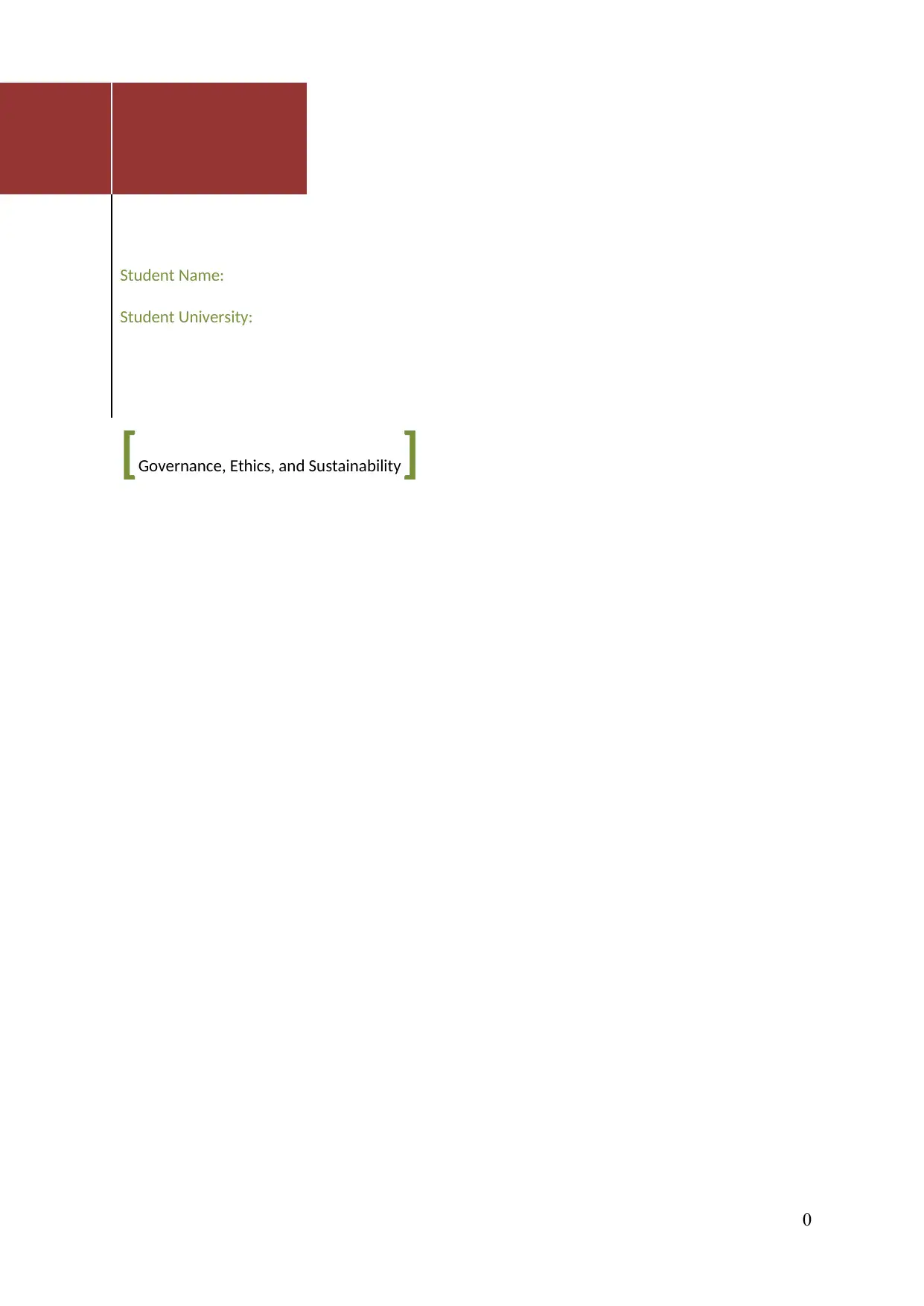
[Governance, Ethics, and Sustainability]
0
Student Name:
Student University:
0
Student Name:
Student University:
Paraphrase This Document
Need a fresh take? Get an instant paraphrase of this document with our AI Paraphraser
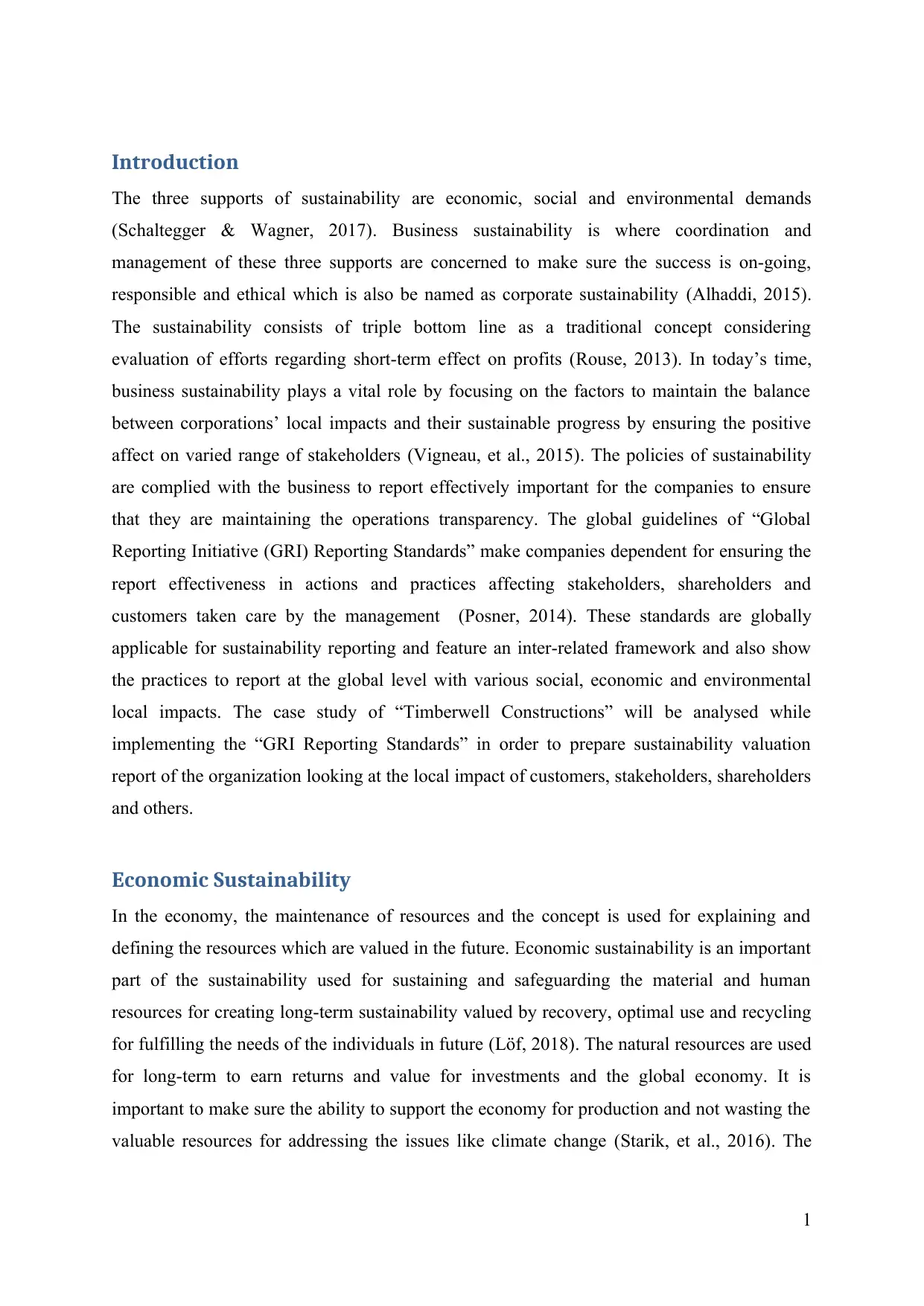
Introduction
The three supports of sustainability are economic, social and environmental demands
(Schaltegger & Wagner, 2017). Business sustainability is where coordination and
management of these three supports are concerned to make sure the success is on-going,
responsible and ethical which is also be named as corporate sustainability (Alhaddi, 2015).
The sustainability consists of triple bottom line as a traditional concept considering
evaluation of efforts regarding short-term effect on profits (Rouse, 2013). In today’s time,
business sustainability plays a vital role by focusing on the factors to maintain the balance
between corporations’ local impacts and their sustainable progress by ensuring the positive
affect on varied range of stakeholders (Vigneau, et al., 2015). The policies of sustainability
are complied with the business to report effectively important for the companies to ensure
that they are maintaining the operations transparency. The global guidelines of “Global
Reporting Initiative (GRI) Reporting Standards” make companies dependent for ensuring the
report effectiveness in actions and practices affecting stakeholders, shareholders and
customers taken care by the management (Posner, 2014). These standards are globally
applicable for sustainability reporting and feature an inter-related framework and also show
the practices to report at the global level with various social, economic and environmental
local impacts. The case study of “Timberwell Constructions” will be analysed while
implementing the “GRI Reporting Standards” in order to prepare sustainability valuation
report of the organization looking at the local impact of customers, stakeholders, shareholders
and others.
Economic Sustainability
In the economy, the maintenance of resources and the concept is used for explaining and
defining the resources which are valued in the future. Economic sustainability is an important
part of the sustainability used for sustaining and safeguarding the material and human
resources for creating long-term sustainability valued by recovery, optimal use and recycling
for fulfilling the needs of the individuals in future (Löf, 2018). The natural resources are used
for long-term to earn returns and value for investments and the global economy. It is
important to make sure the ability to support the economy for production and not wasting the
valuable resources for addressing the issues like climate change (Starik, et al., 2016). The
1
The three supports of sustainability are economic, social and environmental demands
(Schaltegger & Wagner, 2017). Business sustainability is where coordination and
management of these three supports are concerned to make sure the success is on-going,
responsible and ethical which is also be named as corporate sustainability (Alhaddi, 2015).
The sustainability consists of triple bottom line as a traditional concept considering
evaluation of efforts regarding short-term effect on profits (Rouse, 2013). In today’s time,
business sustainability plays a vital role by focusing on the factors to maintain the balance
between corporations’ local impacts and their sustainable progress by ensuring the positive
affect on varied range of stakeholders (Vigneau, et al., 2015). The policies of sustainability
are complied with the business to report effectively important for the companies to ensure
that they are maintaining the operations transparency. The global guidelines of “Global
Reporting Initiative (GRI) Reporting Standards” make companies dependent for ensuring the
report effectiveness in actions and practices affecting stakeholders, shareholders and
customers taken care by the management (Posner, 2014). These standards are globally
applicable for sustainability reporting and feature an inter-related framework and also show
the practices to report at the global level with various social, economic and environmental
local impacts. The case study of “Timberwell Constructions” will be analysed while
implementing the “GRI Reporting Standards” in order to prepare sustainability valuation
report of the organization looking at the local impact of customers, stakeholders, shareholders
and others.
Economic Sustainability
In the economy, the maintenance of resources and the concept is used for explaining and
defining the resources which are valued in the future. Economic sustainability is an important
part of the sustainability used for sustaining and safeguarding the material and human
resources for creating long-term sustainability valued by recovery, optimal use and recycling
for fulfilling the needs of the individuals in future (Löf, 2018). The natural resources are used
for long-term to earn returns and value for investments and the global economy. It is
important to make sure the ability to support the economy for production and not wasting the
valuable resources for addressing the issues like climate change (Starik, et al., 2016). The
1
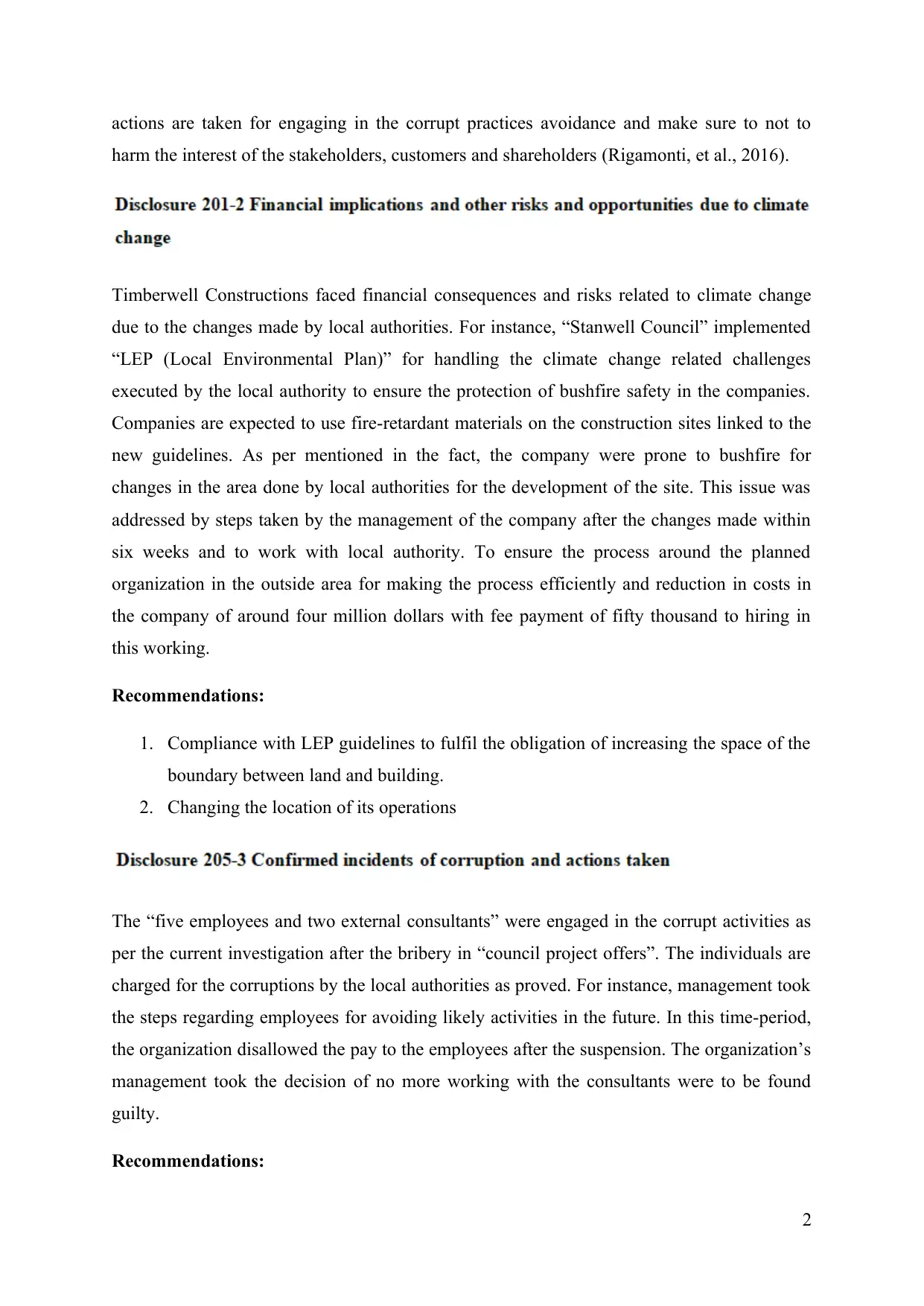
actions are taken for engaging in the corrupt practices avoidance and make sure to not to
harm the interest of the stakeholders, customers and shareholders (Rigamonti, et al., 2016).
Timberwell Constructions faced financial consequences and risks related to climate change
due to the changes made by local authorities. For instance, “Stanwell Council” implemented
“LEP (Local Environmental Plan)” for handling the climate change related challenges
executed by the local authority to ensure the protection of bushfire safety in the companies.
Companies are expected to use fire-retardant materials on the construction sites linked to the
new guidelines. As per mentioned in the fact, the company were prone to bushfire for
changes in the area done by local authorities for the development of the site. This issue was
addressed by steps taken by the management of the company after the changes made within
six weeks and to work with local authority. To ensure the process around the planned
organization in the outside area for making the process efficiently and reduction in costs in
the company of around four million dollars with fee payment of fifty thousand to hiring in
this working.
Recommendations:
1. Compliance with LEP guidelines to fulfil the obligation of increasing the space of the
boundary between land and building.
2. Changing the location of its operations
The “five employees and two external consultants” were engaged in the corrupt activities as
per the current investigation after the bribery in “council project offers”. The individuals are
charged for the corruptions by the local authorities as proved. For instance, management took
the steps regarding employees for avoiding likely activities in the future. In this time-period,
the organization disallowed the pay to the employees after the suspension. The organization’s
management took the decision of no more working with the consultants were to be found
guilty.
Recommendations:
2
harm the interest of the stakeholders, customers and shareholders (Rigamonti, et al., 2016).
Timberwell Constructions faced financial consequences and risks related to climate change
due to the changes made by local authorities. For instance, “Stanwell Council” implemented
“LEP (Local Environmental Plan)” for handling the climate change related challenges
executed by the local authority to ensure the protection of bushfire safety in the companies.
Companies are expected to use fire-retardant materials on the construction sites linked to the
new guidelines. As per mentioned in the fact, the company were prone to bushfire for
changes in the area done by local authorities for the development of the site. This issue was
addressed by steps taken by the management of the company after the changes made within
six weeks and to work with local authority. To ensure the process around the planned
organization in the outside area for making the process efficiently and reduction in costs in
the company of around four million dollars with fee payment of fifty thousand to hiring in
this working.
Recommendations:
1. Compliance with LEP guidelines to fulfil the obligation of increasing the space of the
boundary between land and building.
2. Changing the location of its operations
The “five employees and two external consultants” were engaged in the corrupt activities as
per the current investigation after the bribery in “council project offers”. The individuals are
charged for the corruptions by the local authorities as proved. For instance, management took
the steps regarding employees for avoiding likely activities in the future. In this time-period,
the organization disallowed the pay to the employees after the suspension. The organization’s
management took the decision of no more working with the consultants were to be found
guilty.
Recommendations:
2
⊘ This is a preview!⊘
Do you want full access?
Subscribe today to unlock all pages.

Trusted by 1+ million students worldwide
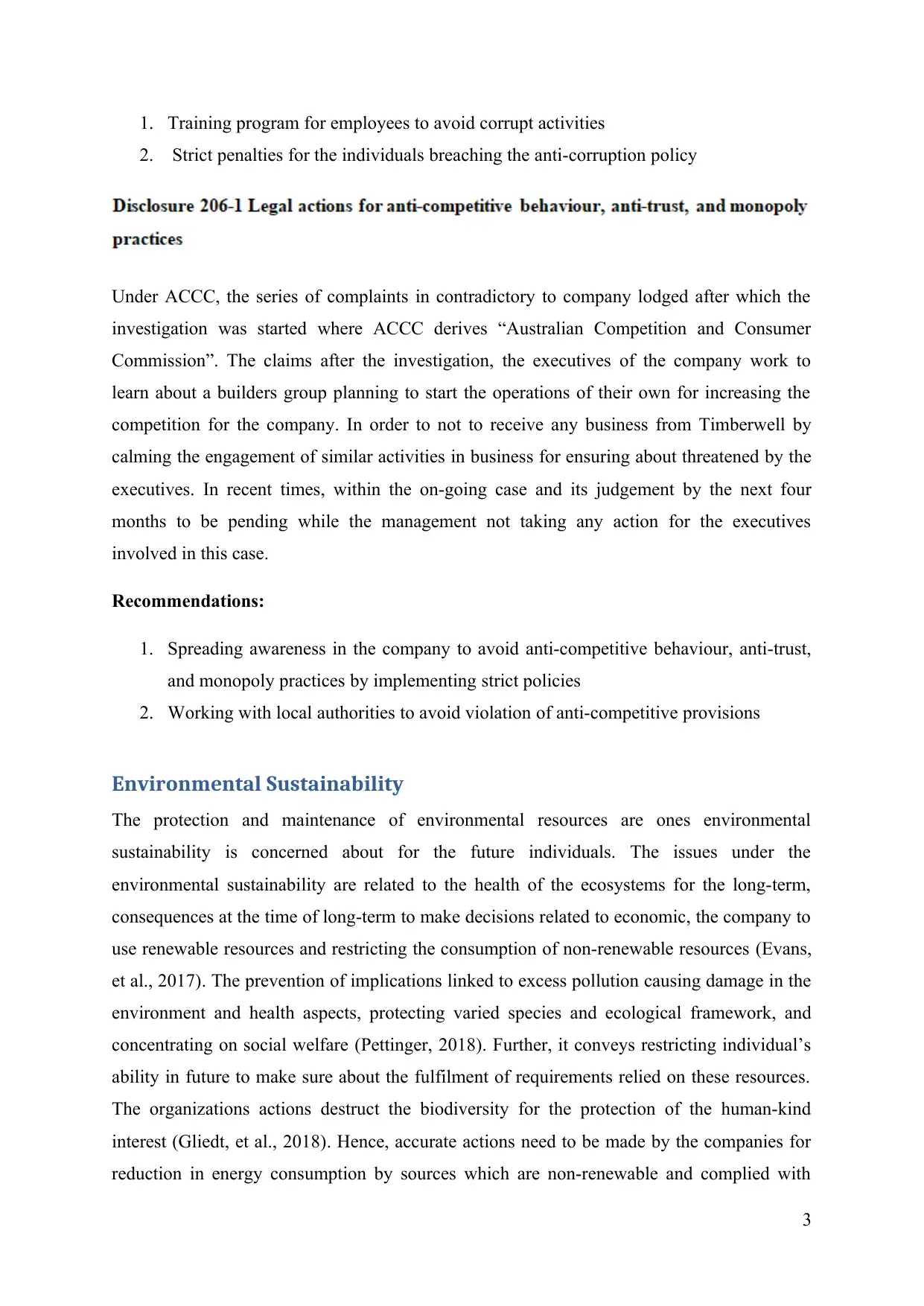
1. Training program for employees to avoid corrupt activities
2. Strict penalties for the individuals breaching the anti-corruption policy
Under ACCC, the series of complaints in contradictory to company lodged after which the
investigation was started where ACCC derives “Australian Competition and Consumer
Commission”. The claims after the investigation, the executives of the company work to
learn about a builders group planning to start the operations of their own for increasing the
competition for the company. In order to not to receive any business from Timberwell by
calming the engagement of similar activities in business for ensuring about threatened by the
executives. In recent times, within the on-going case and its judgement by the next four
months to be pending while the management not taking any action for the executives
involved in this case.
Recommendations:
1. Spreading awareness in the company to avoid anti-competitive behaviour, anti-trust,
and monopoly practices by implementing strict policies
2. Working with local authorities to avoid violation of anti-competitive provisions
Environmental Sustainability
The protection and maintenance of environmental resources are ones environmental
sustainability is concerned about for the future individuals. The issues under the
environmental sustainability are related to the health of the ecosystems for the long-term,
consequences at the time of long-term to make decisions related to economic, the company to
use renewable resources and restricting the consumption of non-renewable resources (Evans,
et al., 2017). The prevention of implications linked to excess pollution causing damage in the
environment and health aspects, protecting varied species and ecological framework, and
concentrating on social welfare (Pettinger, 2018). Further, it conveys restricting individual’s
ability in future to make sure about the fulfilment of requirements relied on these resources.
The organizations actions destruct the biodiversity for the protection of the human-kind
interest (Gliedt, et al., 2018). Hence, accurate actions need to be made by the companies for
reduction in energy consumption by sources which are non-renewable and complied with
3
2. Strict penalties for the individuals breaching the anti-corruption policy
Under ACCC, the series of complaints in contradictory to company lodged after which the
investigation was started where ACCC derives “Australian Competition and Consumer
Commission”. The claims after the investigation, the executives of the company work to
learn about a builders group planning to start the operations of their own for increasing the
competition for the company. In order to not to receive any business from Timberwell by
calming the engagement of similar activities in business for ensuring about threatened by the
executives. In recent times, within the on-going case and its judgement by the next four
months to be pending while the management not taking any action for the executives
involved in this case.
Recommendations:
1. Spreading awareness in the company to avoid anti-competitive behaviour, anti-trust,
and monopoly practices by implementing strict policies
2. Working with local authorities to avoid violation of anti-competitive provisions
Environmental Sustainability
The protection and maintenance of environmental resources are ones environmental
sustainability is concerned about for the future individuals. The issues under the
environmental sustainability are related to the health of the ecosystems for the long-term,
consequences at the time of long-term to make decisions related to economic, the company to
use renewable resources and restricting the consumption of non-renewable resources (Evans,
et al., 2017). The prevention of implications linked to excess pollution causing damage in the
environment and health aspects, protecting varied species and ecological framework, and
concentrating on social welfare (Pettinger, 2018). Further, it conveys restricting individual’s
ability in future to make sure about the fulfilment of requirements relied on these resources.
The organizations actions destruct the biodiversity for the protection of the human-kind
interest (Gliedt, et al., 2018). Hence, accurate actions need to be made by the companies for
reduction in energy consumption by sources which are non-renewable and complied with
3
Paraphrase This Document
Need a fresh take? Get an instant paraphrase of this document with our AI Paraphraser
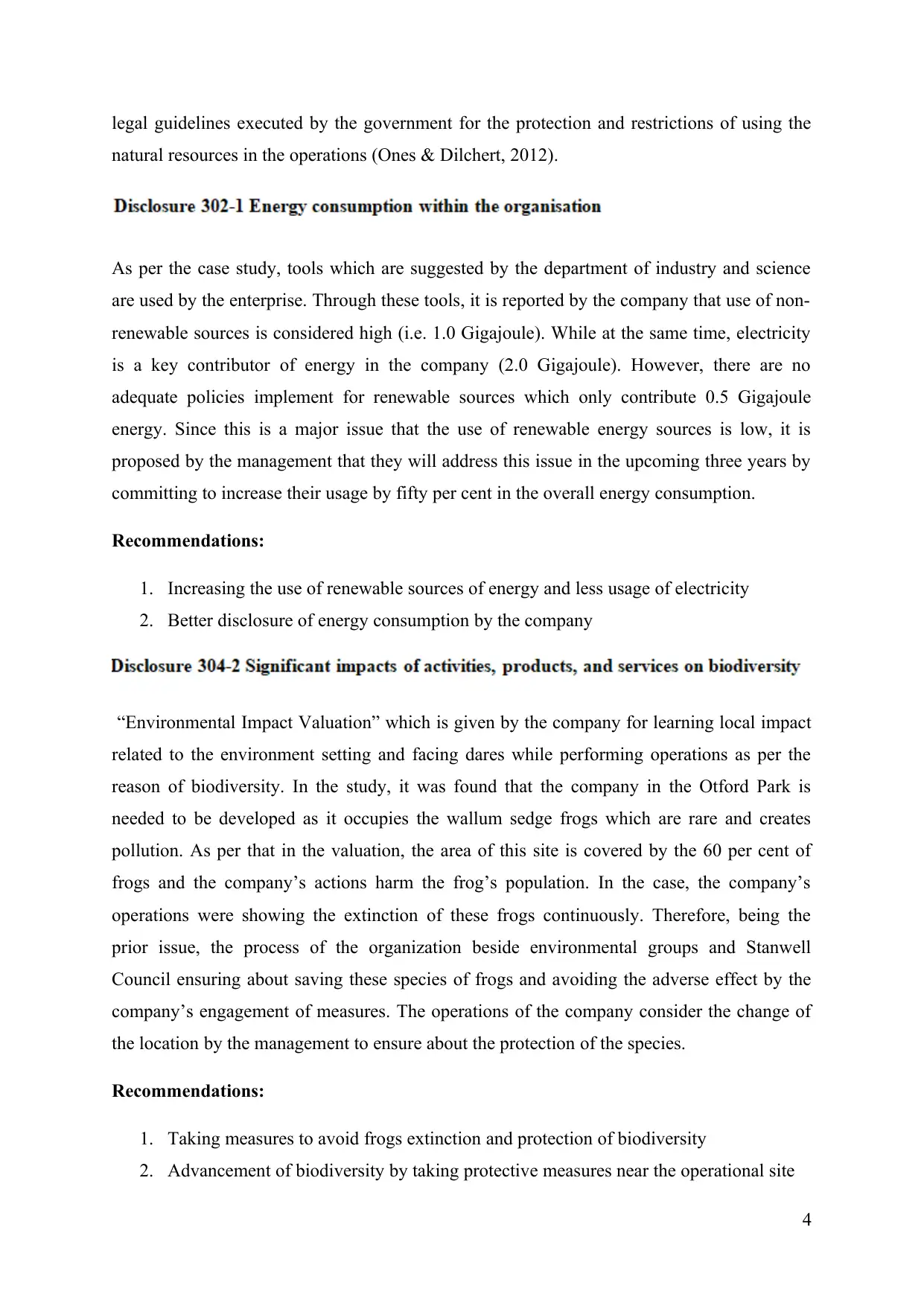
legal guidelines executed by the government for the protection and restrictions of using the
natural resources in the operations (Ones & Dilchert, 2012).
As per the case study, tools which are suggested by the department of industry and science
are used by the enterprise. Through these tools, it is reported by the company that use of non-
renewable sources is considered high (i.e. 1.0 Gigajoule). While at the same time, electricity
is a key contributor of energy in the company (2.0 Gigajoule). However, there are no
adequate policies implement for renewable sources which only contribute 0.5 Gigajoule
energy. Since this is a major issue that the use of renewable energy sources is low, it is
proposed by the management that they will address this issue in the upcoming three years by
committing to increase their usage by fifty per cent in the overall energy consumption.
Recommendations:
1. Increasing the use of renewable sources of energy and less usage of electricity
2. Better disclosure of energy consumption by the company
“Environmental Impact Valuation” which is given by the company for learning local impact
related to the environment setting and facing dares while performing operations as per the
reason of biodiversity. In the study, it was found that the company in the Otford Park is
needed to be developed as it occupies the wallum sedge frogs which are rare and creates
pollution. As per that in the valuation, the area of this site is covered by the 60 per cent of
frogs and the company’s actions harm the frog’s population. In the case, the company’s
operations were showing the extinction of these frogs continuously. Therefore, being the
prior issue, the process of the organization beside environmental groups and Stanwell
Council ensuring about saving these species of frogs and avoiding the adverse effect by the
company’s engagement of measures. The operations of the company consider the change of
the location by the management to ensure about the protection of the species.
Recommendations:
1. Taking measures to avoid frogs extinction and protection of biodiversity
2. Advancement of biodiversity by taking protective measures near the operational site
4
natural resources in the operations (Ones & Dilchert, 2012).
As per the case study, tools which are suggested by the department of industry and science
are used by the enterprise. Through these tools, it is reported by the company that use of non-
renewable sources is considered high (i.e. 1.0 Gigajoule). While at the same time, electricity
is a key contributor of energy in the company (2.0 Gigajoule). However, there are no
adequate policies implement for renewable sources which only contribute 0.5 Gigajoule
energy. Since this is a major issue that the use of renewable energy sources is low, it is
proposed by the management that they will address this issue in the upcoming three years by
committing to increase their usage by fifty per cent in the overall energy consumption.
Recommendations:
1. Increasing the use of renewable sources of energy and less usage of electricity
2. Better disclosure of energy consumption by the company
“Environmental Impact Valuation” which is given by the company for learning local impact
related to the environment setting and facing dares while performing operations as per the
reason of biodiversity. In the study, it was found that the company in the Otford Park is
needed to be developed as it occupies the wallum sedge frogs which are rare and creates
pollution. As per that in the valuation, the area of this site is covered by the 60 per cent of
frogs and the company’s actions harm the frog’s population. In the case, the company’s
operations were showing the extinction of these frogs continuously. Therefore, being the
prior issue, the process of the organization beside environmental groups and Stanwell
Council ensuring about saving these species of frogs and avoiding the adverse effect by the
company’s engagement of measures. The operations of the company consider the change of
the location by the management to ensure about the protection of the species.
Recommendations:
1. Taking measures to avoid frogs extinction and protection of biodiversity
2. Advancement of biodiversity by taking protective measures near the operational site
4
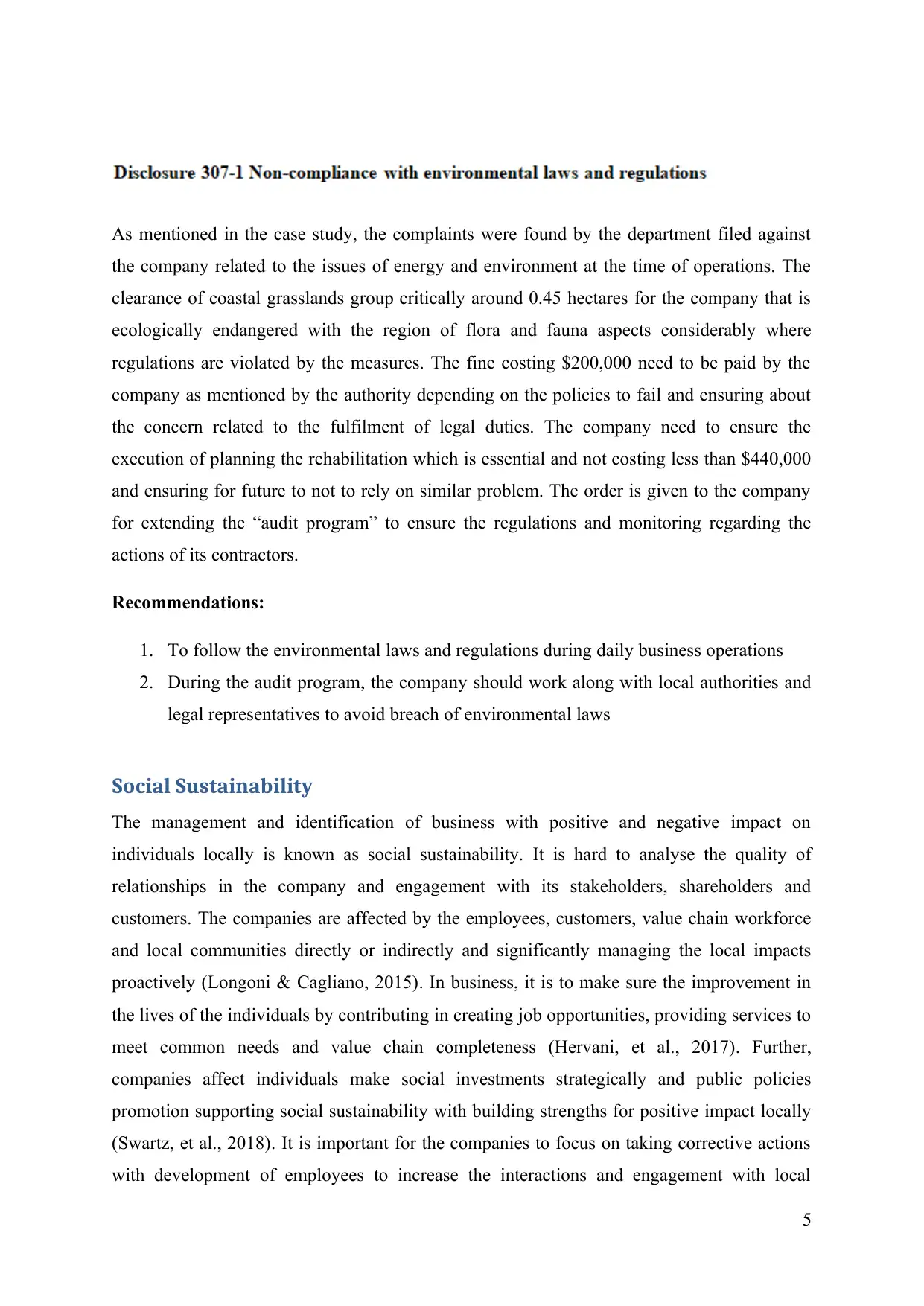
As mentioned in the case study, the complaints were found by the department filed against
the company related to the issues of energy and environment at the time of operations. The
clearance of coastal grasslands group critically around 0.45 hectares for the company that is
ecologically endangered with the region of flora and fauna aspects considerably where
regulations are violated by the measures. The fine costing $200,000 need to be paid by the
company as mentioned by the authority depending on the policies to fail and ensuring about
the concern related to the fulfilment of legal duties. The company need to ensure the
execution of planning the rehabilitation which is essential and not costing less than $440,000
and ensuring for future to not to rely on similar problem. The order is given to the company
for extending the “audit program” to ensure the regulations and monitoring regarding the
actions of its contractors.
Recommendations:
1. To follow the environmental laws and regulations during daily business operations
2. During the audit program, the company should work along with local authorities and
legal representatives to avoid breach of environmental laws
Social Sustainability
The management and identification of business with positive and negative impact on
individuals locally is known as social sustainability. It is hard to analyse the quality of
relationships in the company and engagement with its stakeholders, shareholders and
customers. The companies are affected by the employees, customers, value chain workforce
and local communities directly or indirectly and significantly managing the local impacts
proactively (Longoni & Cagliano, 2015). In business, it is to make sure the improvement in
the lives of the individuals by contributing in creating job opportunities, providing services to
meet common needs and value chain completeness (Hervani, et al., 2017). Further,
companies affect individuals make social investments strategically and public policies
promotion supporting social sustainability with building strengths for positive impact locally
(Swartz, et al., 2018). It is important for the companies to focus on taking corrective actions
with development of employees to increase the interactions and engagement with local
5
the company related to the issues of energy and environment at the time of operations. The
clearance of coastal grasslands group critically around 0.45 hectares for the company that is
ecologically endangered with the region of flora and fauna aspects considerably where
regulations are violated by the measures. The fine costing $200,000 need to be paid by the
company as mentioned by the authority depending on the policies to fail and ensuring about
the concern related to the fulfilment of legal duties. The company need to ensure the
execution of planning the rehabilitation which is essential and not costing less than $440,000
and ensuring for future to not to rely on similar problem. The order is given to the company
for extending the “audit program” to ensure the regulations and monitoring regarding the
actions of its contractors.
Recommendations:
1. To follow the environmental laws and regulations during daily business operations
2. During the audit program, the company should work along with local authorities and
legal representatives to avoid breach of environmental laws
Social Sustainability
The management and identification of business with positive and negative impact on
individuals locally is known as social sustainability. It is hard to analyse the quality of
relationships in the company and engagement with its stakeholders, shareholders and
customers. The companies are affected by the employees, customers, value chain workforce
and local communities directly or indirectly and significantly managing the local impacts
proactively (Longoni & Cagliano, 2015). In business, it is to make sure the improvement in
the lives of the individuals by contributing in creating job opportunities, providing services to
meet common needs and value chain completeness (Hervani, et al., 2017). Further,
companies affect individuals make social investments strategically and public policies
promotion supporting social sustainability with building strengths for positive impact locally
(Swartz, et al., 2018). It is important for the companies to focus on taking corrective actions
with development of employees to increase the interactions and engagement with local
5
⊘ This is a preview!⊘
Do you want full access?
Subscribe today to unlock all pages.

Trusted by 1+ million students worldwide
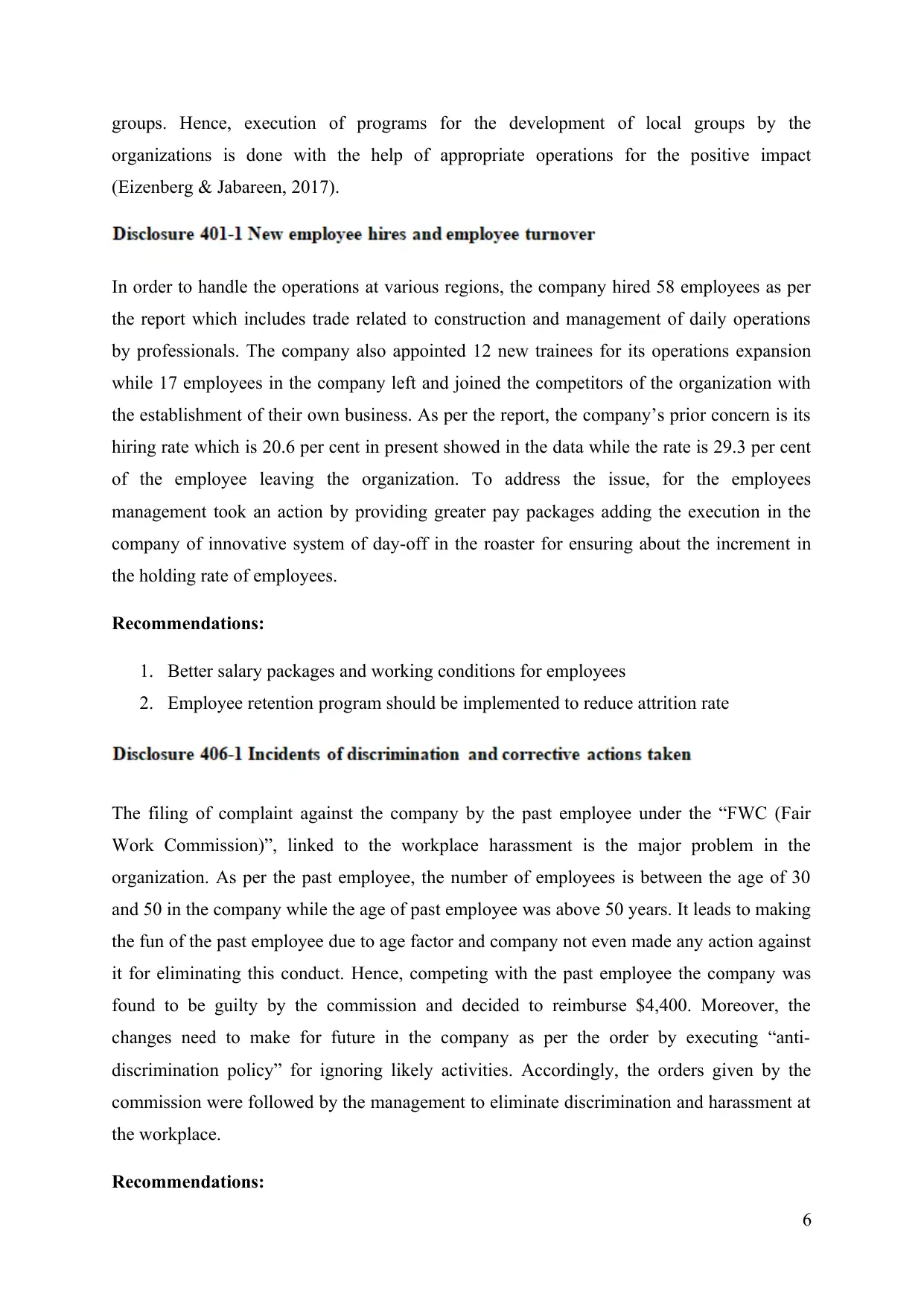
groups. Hence, execution of programs for the development of local groups by the
organizations is done with the help of appropriate operations for the positive impact
(Eizenberg & Jabareen, 2017).
In order to handle the operations at various regions, the company hired 58 employees as per
the report which includes trade related to construction and management of daily operations
by professionals. The company also appointed 12 new trainees for its operations expansion
while 17 employees in the company left and joined the competitors of the organization with
the establishment of their own business. As per the report, the company’s prior concern is its
hiring rate which is 20.6 per cent in present showed in the data while the rate is 29.3 per cent
of the employee leaving the organization. To address the issue, for the employees
management took an action by providing greater pay packages adding the execution in the
company of innovative system of day-off in the roaster for ensuring about the increment in
the holding rate of employees.
Recommendations:
1. Better salary packages and working conditions for employees
2. Employee retention program should be implemented to reduce attrition rate
The filing of complaint against the company by the past employee under the “FWC (Fair
Work Commission)”, linked to the workplace harassment is the major problem in the
organization. As per the past employee, the number of employees is between the age of 30
and 50 in the company while the age of past employee was above 50 years. It leads to making
the fun of the past employee due to age factor and company not even made any action against
it for eliminating this conduct. Hence, competing with the past employee the company was
found to be guilty by the commission and decided to reimburse $4,400. Moreover, the
changes need to make for future in the company as per the order by executing “anti-
discrimination policy” for ignoring likely activities. Accordingly, the orders given by the
commission were followed by the management to eliminate discrimination and harassment at
the workplace.
Recommendations:
6
organizations is done with the help of appropriate operations for the positive impact
(Eizenberg & Jabareen, 2017).
In order to handle the operations at various regions, the company hired 58 employees as per
the report which includes trade related to construction and management of daily operations
by professionals. The company also appointed 12 new trainees for its operations expansion
while 17 employees in the company left and joined the competitors of the organization with
the establishment of their own business. As per the report, the company’s prior concern is its
hiring rate which is 20.6 per cent in present showed in the data while the rate is 29.3 per cent
of the employee leaving the organization. To address the issue, for the employees
management took an action by providing greater pay packages adding the execution in the
company of innovative system of day-off in the roaster for ensuring about the increment in
the holding rate of employees.
Recommendations:
1. Better salary packages and working conditions for employees
2. Employee retention program should be implemented to reduce attrition rate
The filing of complaint against the company by the past employee under the “FWC (Fair
Work Commission)”, linked to the workplace harassment is the major problem in the
organization. As per the past employee, the number of employees is between the age of 30
and 50 in the company while the age of past employee was above 50 years. It leads to making
the fun of the past employee due to age factor and company not even made any action against
it for eliminating this conduct. Hence, competing with the past employee the company was
found to be guilty by the commission and decided to reimburse $4,400. Moreover, the
changes need to make for future in the company as per the order by executing “anti-
discrimination policy” for ignoring likely activities. Accordingly, the orders given by the
commission were followed by the management to eliminate discrimination and harassment at
the workplace.
Recommendations:
6
Paraphrase This Document
Need a fresh take? Get an instant paraphrase of this document with our AI Paraphraser
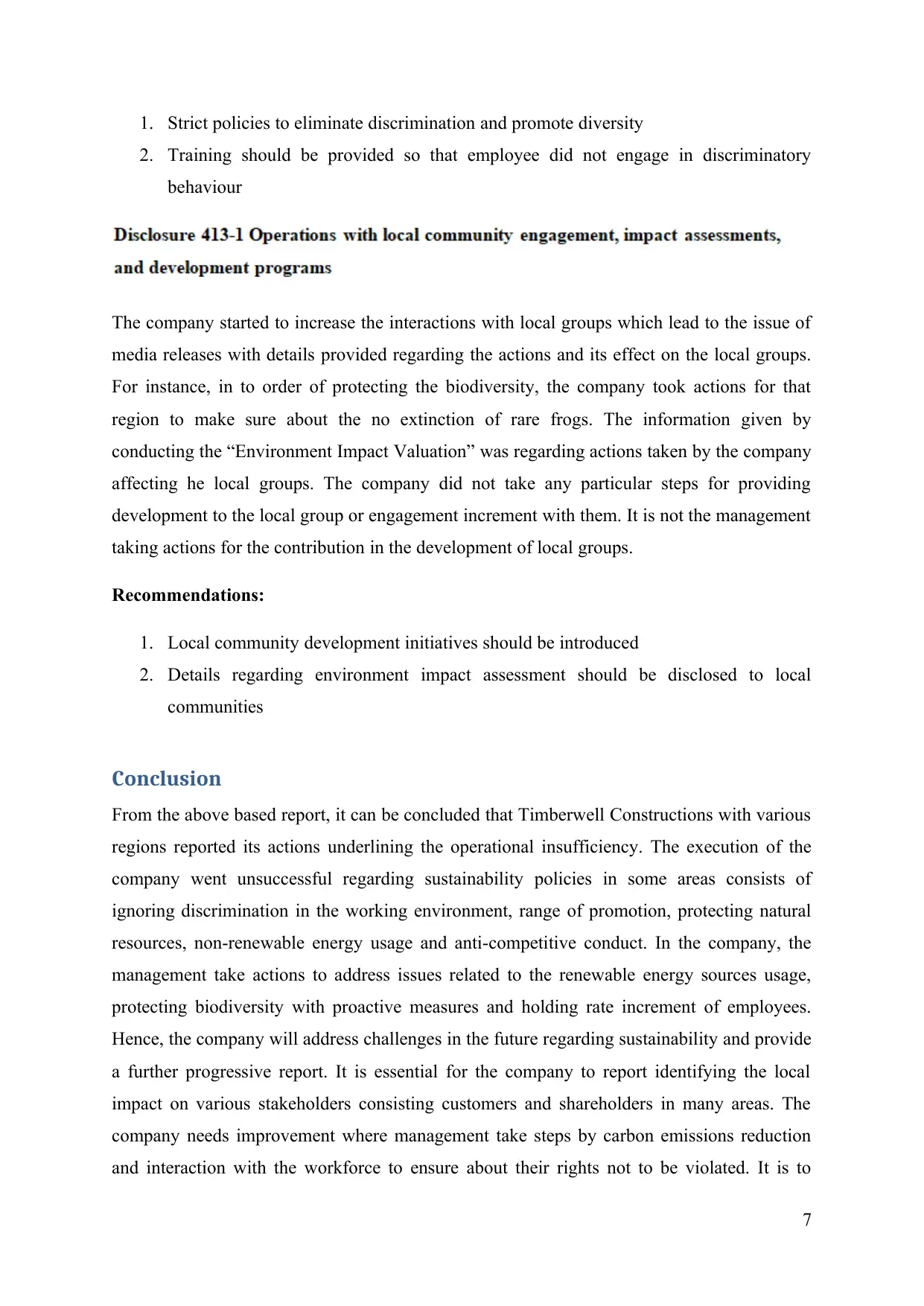
1. Strict policies to eliminate discrimination and promote diversity
2. Training should be provided so that employee did not engage in discriminatory
behaviour
The company started to increase the interactions with local groups which lead to the issue of
media releases with details provided regarding the actions and its effect on the local groups.
For instance, in to order of protecting the biodiversity, the company took actions for that
region to make sure about the no extinction of rare frogs. The information given by
conducting the “Environment Impact Valuation” was regarding actions taken by the company
affecting he local groups. The company did not take any particular steps for providing
development to the local group or engagement increment with them. It is not the management
taking actions for the contribution in the development of local groups.
Recommendations:
1. Local community development initiatives should be introduced
2. Details regarding environment impact assessment should be disclosed to local
communities
Conclusion
From the above based report, it can be concluded that Timberwell Constructions with various
regions reported its actions underlining the operational insufficiency. The execution of the
company went unsuccessful regarding sustainability policies in some areas consists of
ignoring discrimination in the working environment, range of promotion, protecting natural
resources, non-renewable energy usage and anti-competitive conduct. In the company, the
management take actions to address issues related to the renewable energy sources usage,
protecting biodiversity with proactive measures and holding rate increment of employees.
Hence, the company will address challenges in the future regarding sustainability and provide
a further progressive report. It is essential for the company to report identifying the local
impact on various stakeholders consisting customers and shareholders in many areas. The
company needs improvement where management take steps by carbon emissions reduction
and interaction with the workforce to ensure about their rights not to be violated. It is to
7
2. Training should be provided so that employee did not engage in discriminatory
behaviour
The company started to increase the interactions with local groups which lead to the issue of
media releases with details provided regarding the actions and its effect on the local groups.
For instance, in to order of protecting the biodiversity, the company took actions for that
region to make sure about the no extinction of rare frogs. The information given by
conducting the “Environment Impact Valuation” was regarding actions taken by the company
affecting he local groups. The company did not take any particular steps for providing
development to the local group or engagement increment with them. It is not the management
taking actions for the contribution in the development of local groups.
Recommendations:
1. Local community development initiatives should be introduced
2. Details regarding environment impact assessment should be disclosed to local
communities
Conclusion
From the above based report, it can be concluded that Timberwell Constructions with various
regions reported its actions underlining the operational insufficiency. The execution of the
company went unsuccessful regarding sustainability policies in some areas consists of
ignoring discrimination in the working environment, range of promotion, protecting natural
resources, non-renewable energy usage and anti-competitive conduct. In the company, the
management take actions to address issues related to the renewable energy sources usage,
protecting biodiversity with proactive measures and holding rate increment of employees.
Hence, the company will address challenges in the future regarding sustainability and provide
a further progressive report. It is essential for the company to report identifying the local
impact on various stakeholders consisting customers and shareholders in many areas. The
company needs improvement where management take steps by carbon emissions reduction
and interaction with the workforce to ensure about their rights not to be violated. It is to
7
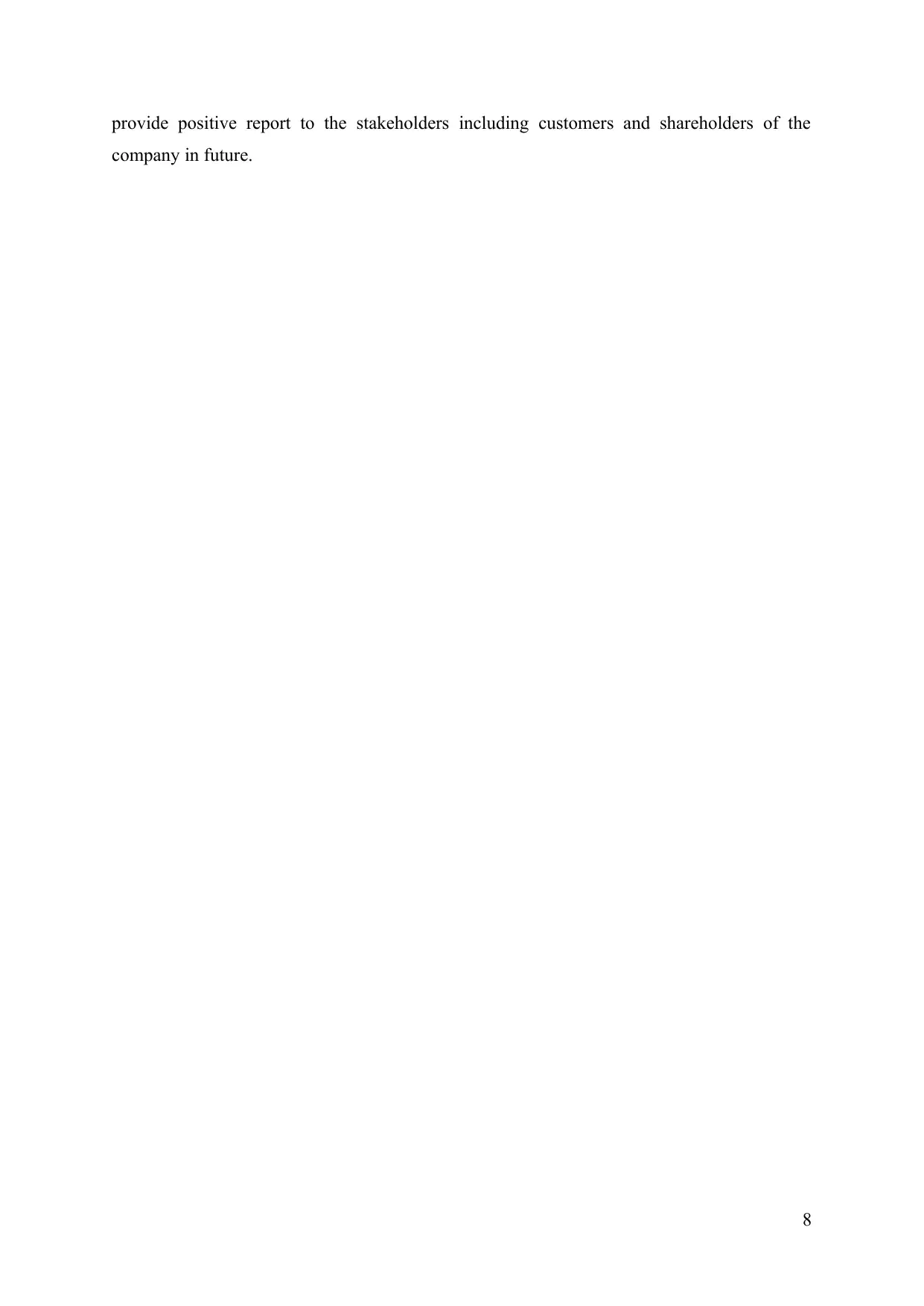
provide positive report to the stakeholders including customers and shareholders of the
company in future.
8
company in future.
8
⊘ This is a preview!⊘
Do you want full access?
Subscribe today to unlock all pages.

Trusted by 1+ million students worldwide
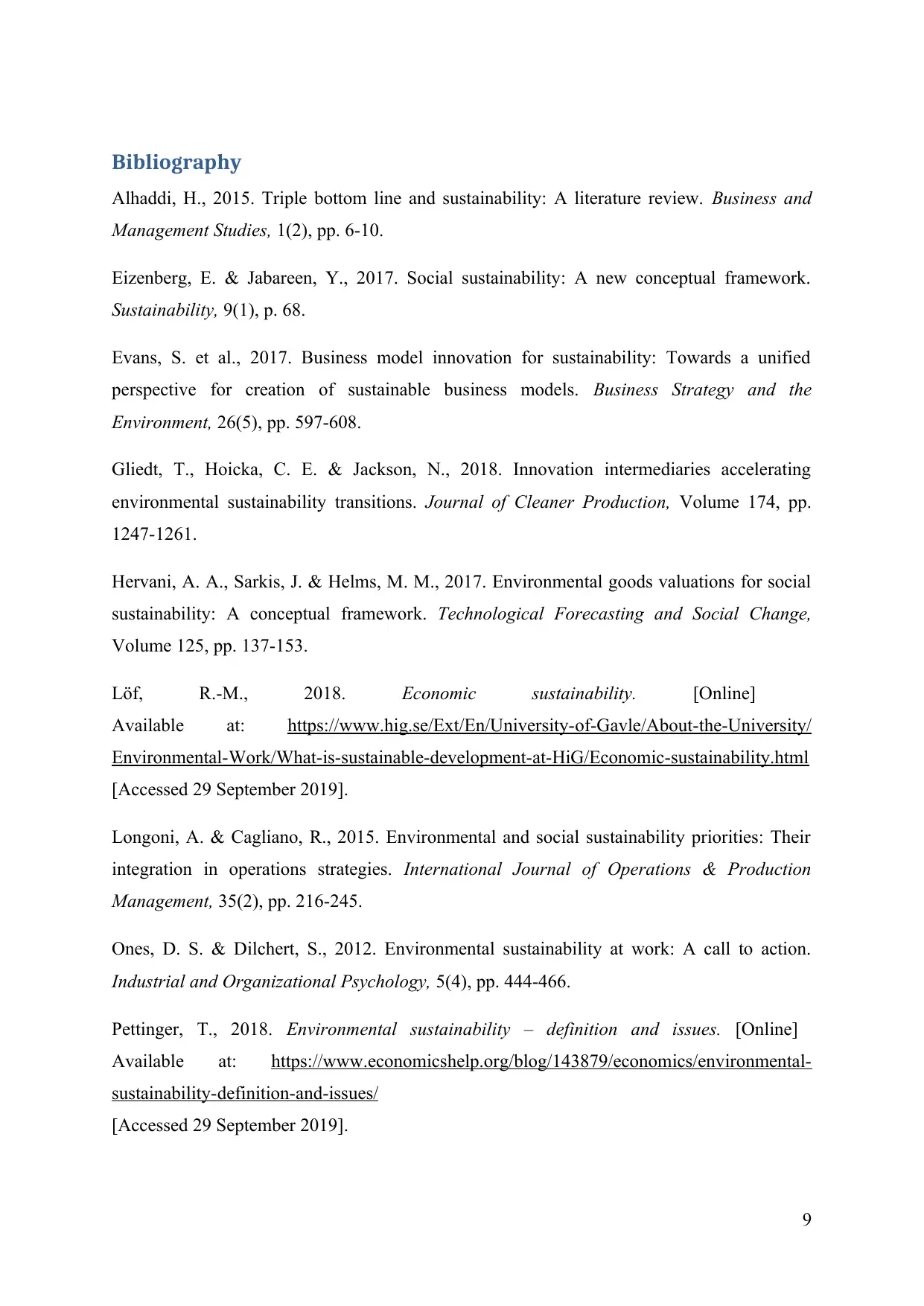
Bibliography
Alhaddi, H., 2015. Triple bottom line and sustainability: A literature review. Business and
Management Studies, 1(2), pp. 6-10.
Eizenberg, E. & Jabareen, Y., 2017. Social sustainability: A new conceptual framework.
Sustainability, 9(1), p. 68.
Evans, S. et al., 2017. Business model innovation for sustainability: Towards a unified
perspective for creation of sustainable business models. Business Strategy and the
Environment, 26(5), pp. 597-608.
Gliedt, T., Hoicka, C. E. & Jackson, N., 2018. Innovation intermediaries accelerating
environmental sustainability transitions. Journal of Cleaner Production, Volume 174, pp.
1247-1261.
Hervani, A. A., Sarkis, J. & Helms, M. M., 2017. Environmental goods valuations for social
sustainability: A conceptual framework. Technological Forecasting and Social Change,
Volume 125, pp. 137-153.
Löf, R.-M., 2018. Economic sustainability. [Online]
Available at: https://www.hig.se/Ext/En/University-of-Gavle/About-the-University/
Environmental-Work/What-is-sustainable-development-at-HiG/Economic-sustainability.html
[Accessed 29 September 2019].
Longoni, A. & Cagliano, R., 2015. Environmental and social sustainability priorities: Their
integration in operations strategies. International Journal of Operations & Production
Management, 35(2), pp. 216-245.
Ones, D. S. & Dilchert, S., 2012. Environmental sustainability at work: A call to action.
Industrial and Organizational Psychology, 5(4), pp. 444-466.
Pettinger, T., 2018. Environmental sustainability – definition and issues. [Online]
Available at: https://www.economicshelp.org/blog/143879/economics/environmental-
sustainability-definition-and-issues/
[Accessed 29 September 2019].
9
Alhaddi, H., 2015. Triple bottom line and sustainability: A literature review. Business and
Management Studies, 1(2), pp. 6-10.
Eizenberg, E. & Jabareen, Y., 2017. Social sustainability: A new conceptual framework.
Sustainability, 9(1), p. 68.
Evans, S. et al., 2017. Business model innovation for sustainability: Towards a unified
perspective for creation of sustainable business models. Business Strategy and the
Environment, 26(5), pp. 597-608.
Gliedt, T., Hoicka, C. E. & Jackson, N., 2018. Innovation intermediaries accelerating
environmental sustainability transitions. Journal of Cleaner Production, Volume 174, pp.
1247-1261.
Hervani, A. A., Sarkis, J. & Helms, M. M., 2017. Environmental goods valuations for social
sustainability: A conceptual framework. Technological Forecasting and Social Change,
Volume 125, pp. 137-153.
Löf, R.-M., 2018. Economic sustainability. [Online]
Available at: https://www.hig.se/Ext/En/University-of-Gavle/About-the-University/
Environmental-Work/What-is-sustainable-development-at-HiG/Economic-sustainability.html
[Accessed 29 September 2019].
Longoni, A. & Cagliano, R., 2015. Environmental and social sustainability priorities: Their
integration in operations strategies. International Journal of Operations & Production
Management, 35(2), pp. 216-245.
Ones, D. S. & Dilchert, S., 2012. Environmental sustainability at work: A call to action.
Industrial and Organizational Psychology, 5(4), pp. 444-466.
Pettinger, T., 2018. Environmental sustainability – definition and issues. [Online]
Available at: https://www.economicshelp.org/blog/143879/economics/environmental-
sustainability-definition-and-issues/
[Accessed 29 September 2019].
9
Paraphrase This Document
Need a fresh take? Get an instant paraphrase of this document with our AI Paraphraser
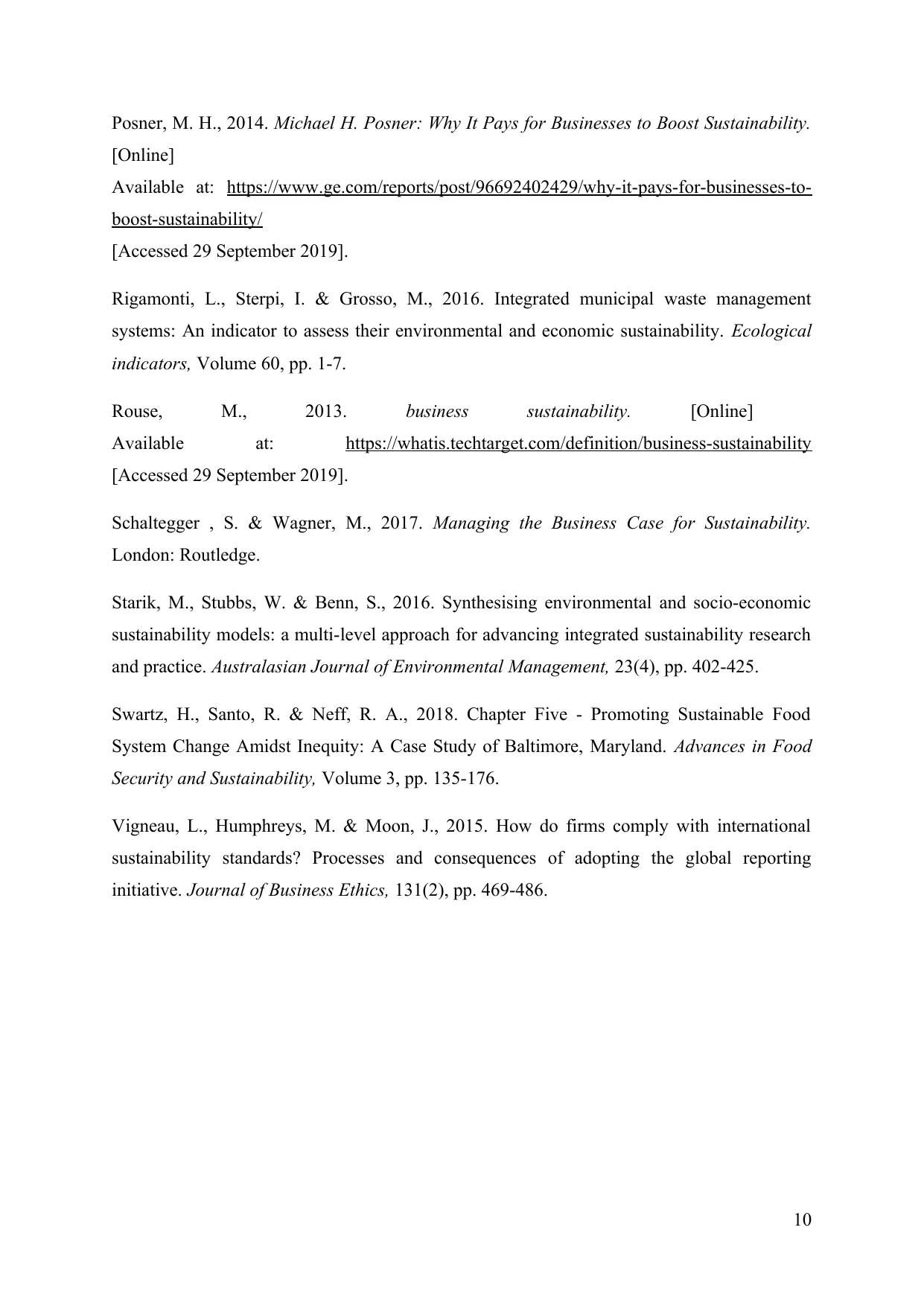
Posner, M. H., 2014. Michael H. Posner: Why It Pays for Businesses to Boost Sustainability.
[Online]
Available at: https://www.ge.com/reports/post/96692402429/why-it-pays-for-businesses-to-
boost-sustainability/
[Accessed 29 September 2019].
Rigamonti, L., Sterpi, I. & Grosso, M., 2016. Integrated municipal waste management
systems: An indicator to assess their environmental and economic sustainability. Ecological
indicators, Volume 60, pp. 1-7.
Rouse, M., 2013. business sustainability. [Online]
Available at: https://whatis.techtarget.com/definition/business-sustainability
[Accessed 29 September 2019].
Schaltegger , S. & Wagner, M., 2017. Managing the Business Case for Sustainability.
London: Routledge.
Starik, M., Stubbs, W. & Benn, S., 2016. Synthesising environmental and socio-economic
sustainability models: a multi-level approach for advancing integrated sustainability research
and practice. Australasian Journal of Environmental Management, 23(4), pp. 402-425.
Swartz, H., Santo, R. & Neff, R. A., 2018. Chapter Five - Promoting Sustainable Food
System Change Amidst Inequity: A Case Study of Baltimore, Maryland. Advances in Food
Security and Sustainability, Volume 3, pp. 135-176.
Vigneau, L., Humphreys, M. & Moon, J., 2015. How do firms comply with international
sustainability standards? Processes and consequences of adopting the global reporting
initiative. Journal of Business Ethics, 131(2), pp. 469-486.
10
[Online]
Available at: https://www.ge.com/reports/post/96692402429/why-it-pays-for-businesses-to-
boost-sustainability/
[Accessed 29 September 2019].
Rigamonti, L., Sterpi, I. & Grosso, M., 2016. Integrated municipal waste management
systems: An indicator to assess their environmental and economic sustainability. Ecological
indicators, Volume 60, pp. 1-7.
Rouse, M., 2013. business sustainability. [Online]
Available at: https://whatis.techtarget.com/definition/business-sustainability
[Accessed 29 September 2019].
Schaltegger , S. & Wagner, M., 2017. Managing the Business Case for Sustainability.
London: Routledge.
Starik, M., Stubbs, W. & Benn, S., 2016. Synthesising environmental and socio-economic
sustainability models: a multi-level approach for advancing integrated sustainability research
and practice. Australasian Journal of Environmental Management, 23(4), pp. 402-425.
Swartz, H., Santo, R. & Neff, R. A., 2018. Chapter Five - Promoting Sustainable Food
System Change Amidst Inequity: A Case Study of Baltimore, Maryland. Advances in Food
Security and Sustainability, Volume 3, pp. 135-176.
Vigneau, L., Humphreys, M. & Moon, J., 2015. How do firms comply with international
sustainability standards? Processes and consequences of adopting the global reporting
initiative. Journal of Business Ethics, 131(2), pp. 469-486.
10
1 out of 11
Related Documents
Your All-in-One AI-Powered Toolkit for Academic Success.
+13062052269
info@desklib.com
Available 24*7 on WhatsApp / Email
![[object Object]](/_next/static/media/star-bottom.7253800d.svg)
Unlock your academic potential
Copyright © 2020–2025 A2Z Services. All Rights Reserved. Developed and managed by ZUCOL.





